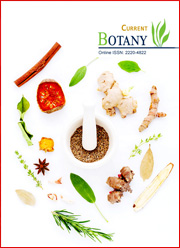Effect of vermicompost enriched with bacterial endophytes (Azospirillum and Rhizobium) on growth and yield of tomato
DOI:
https://doi.org/10.25081/cb.2024.v15.8839Keywords:
Vermicompost, Tomato, Endophytes, Rhizobium, Azospirillum, Chemical fetilizerAbstract
The extensive use of chemical fertilizers has served as a response to the increasing need for crop production in recent decades. While it addresses the demand for food, it has resulted in a decline in crop productivity and a heightened negative environmental impact. In contrast, bacterial endophytes namely Azospirillum and Rhizobium and vermicompost offer a promising alternative to mitigate the negative consequences of chemical fertilizers. It can enhance nutrient availability, promote plant growth, and improve nutrient uptake efficiency, thereby reducing the reliance on chemical fertilizers. In this study, two bacterial endophytes Azospirillum and Rhizobium, combination with vermicompost and chemical fertilizer were used to investigate their potential role in the enhancement of growth yields of tomato. The inoculation of bacterial endophytes enhanced the root and shoot length, biomass and leaf chlorophyll contents. The fruit weight of the tomato (kg/plant) was also higher in the vermicompost and bacteria inoculated plants of tomato than in the chemical fertilizer. The mixed application of vermicompost with the combination of Azospirillum and Rhizobium showed the best performance compared to other treatments.
Downloads
References
Aurora, D., Alina, N., Oana, B., Andrei, M., Mihela, Z., & Liliana, B. (2019). Nutritional quality parameters of the fresh red tomato varieties cultivated in organic system. Scientific Papers. Series B, Horticulture, 63, 439-443.
Bhat, S. A., Singh, S., Singh, J., Kumar, S., Bhawana, & Vig, A. P. (2018). Bioremediation and detoxification of industrial wastes by earthworms: Vermicompost as powerful crop nutrient in sustainable agriculture. Bioresource Technology, 252, 172-179. https://doi.org/10.1016/j.biortech.2018.01.003
Cantanazaro, C. J., Williams, K. A., & Sauve, R. J. (1998). Slow release versus water soluble fertilization affects nutrient leaching and growth of potted Chrysanthemum. Journal of Plant Nutrition, 21(5), 1025-1036. https://doi.org/10.1080/01904169809365461
Cavalcante, V. A., & Dobereiner, J. (1998). A new acid tolerant nitrogen fixing bacterium associated with sugarcane. Plant and Soil, 108, 23-31. https://doi.org/10.1007/BF02370096
FAOSTAT. (2020). Crops and livestock products. Retrieved from http://www.fao.org/faostat/en/#data/QC
Felföldi, Z., Ranga, F., Socaci, S. A., Farcas, A., Plazas, M., Sestras, A. F., Vodnar, D. C., Prohens, J., & Sestras, R. E. (2021). Physico-chemical, nutritional, and sensory evaluation of two new commercial tomato hybrids and their parental lines. Plants, 10(11), 2480. https://doi.org/10.3390/plants10112480
Gamo, T., & Ahn, S. B. (1991). Growthpromoting Azospirillum spp. isolated from the roots of several non-gramineous crops in Japan. Soil Science and Plant Nutrition, 37(3), 455-461. https://doi.org/10.1080/00380768.1991.10415058
Hait, S., & Tare, V. (2012). Transformation and availability of nutrients and heavy metals during integrated composting-vermicomposting of sewage sludges. Ecotoxicology and Environmental Safety, 79, 214-224. https://doi.org/10.1016/j.ecoenv.2012.01.004
Hardoim, P. R., van Overbeek, L. S., & Elsas, J. D. (2008). Properties of bacterial endophytes and their proposed role in plant growth. Trends in Microbiology, 16(10), 463-471. https://doi.org/10.1016/j.tim.2008.07.008
Joshi, R., & Vig, A. P. (2010). Effect of vermicompost on growth, yield and quality of tomato (Lycopersicum esculentum L). African Journal of Basic & Applied Sciences, 2(3-4), 117-123.
Kashem, M. A., Sarker, A., Hossain, I., & Islam, M. S. (2015). Comparison of the effect of vermicompost and inorganic fertilizers on vegetative growth and fruit production of tomato (Solanum lycopersicum L.). Open Journal of Soil Science, 5(2), 53-58. https://doi.org/10.4236/ojss.2015.52006
Lodewyckz, C., Vangronsveld, J., & Porteus, F. (2002). Endophytic bacteria and their potential applications. Critical Reviews in Plant Sciences, 21(6), 583-606. https://doi.org/10.1080/0735-260291044377
Najar, I. A., & Khan, A. B. (2013). Management of fresh water weeds (Macrophytes) by vermicomposting using Eisenia fetida. Environmental Science and Pollution Research International, 20(9), 6406-6417. https://doi.org/10.1007/s11356-013-1687-9
Polat, E., Demir, H., & Erler, F. (2010). Yield and quality criteria in organically and conventionally grown tomatoes in Turkey. Scientia Agricola, 67(4), 424-429. https://doi.org/10.1590/S0103-90162010000400008
Ray, R. C., El Sheikha, A. F., Panda, S. H., & Montet, D. (2011). Anti-oxidant properties and other functional attributes of tomato: An overview. International Journal of Food and Fermentation Technology, 1(2), 139-148.
Reinhold-Hurek, B., Hurek, T., Gillis, M., Hoste, B., Vancanney, M., Kersters, K., & De Ley, J. (1993). Azoarcus gen. nov., nitrogen fixing probacteria associated with roots of kallar grass (Leptochloa fusca, (L). Kunth, and description of two species: Azoarcus indigens sp. nov. and Azoarcus communis sp. nov. International Journal of Systematic and Evolutionary Microbiology, 43(3), 574-584. https://doi.org/10.1099/00207713-43-3-574
Sangwan, P., Garg, V. K., & Kaushik, C. P. (2010). Growth and yield response of marigold to potting media containing vermicompost produced from different wastes. The Environmentalist, 30, 123-130. https://doi.org/10.1007/s10669-009-9251-3
Steenhoudt, O., & Vanderleyden, J. (2000). Azospirillum, a free-living nitrogen-fixing bacterium closely associated with grasses: genetic, biochemical and ecological aspects. FEMS Microbiology Reviews, 24(4), 487-506. https://doi.org/10.1111/j.1574-6976.2000.tb00552.x
Stoleru, V., Inculet, S.-C., Mihalache, G., Cojocaru, A., Teliban, G.-C., & Caruso, G. (2020). Yield and nutritional response of greenhouse grown tomato cultivars to sustainable fertilization and irrigation management. Plants, 9(8), 1053. https://doi.org/10.3390/plants9081053
Tareen, M. J., Abbasi, N. A., & Hafiz, I. A. (2012). Effect of salicylic acid treatments on storage life of peach fruit Cv. “Flordaking”. Pakistan Journal of Botany, 44(1), 119-124.
Thakur, B. R., Singh, R. K., & Nelson, P. E. (1996). Quality attributes of processed tomato products: A review. Food Reviews International, 12(3), 375-401. https://doi.org/10.1080/87559129609541085
Ulrich, K., Ulrich, A., & Ewald, D. (2008). Diversity of endophytic bacterial community in popular growth under field conditions. FEMS Microbiology Ecology, 163(2), 169-180. https://doi.org/10.1111/j.1574-6941.2007.00419.x
Weyens, N., van der Lelie, D., Taghavi, S., & Vangronsveld, J. (2009). Phytoremediation: Plant endophyte partnerships take the challenge. Current Opinion in Biotechnology, 20, 248-254. https://doi.org/10.1016/j.copbio.2009.02.012
Zhou, F. Y., & You, C. B. (1988). Interaction between diazotrophic bacteria Alcaligenes faecalis and host plant rice. Scientia Agricultura Sinica, 21, 7-13.
Zoltán, F., Florica, R., Ioana, A., Adriana, F., Dan, C., Jaime, P., & Radu, E. (2022). Analysis of physico-chemical and organoleptic fruit parameters relevant for tomato quality. Agronomy, 12(5), 1232. https://doi.org/10.3390/agronomy12051232
Published
How to Cite
Issue
Section
Copyright (c) 2024 S. Nithya, K. Sasikumar, O. S. Sethu Raman

This work is licensed under a Creative Commons Attribution-NonCommercial 3.0 Unported License.



 .
.